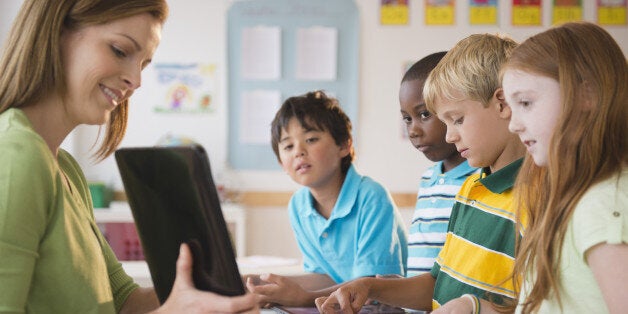
The holiday season is behind us, leaving in its wake newly-unwrapped gifts and a host of stimulating digital toys and games intricately designed to build our brains for the new world order. As parents, we are overwhelmed -- dare we say flummoxed -- by the sheer amount of so-called "educational" e-products that we can now buy for our children. Indeed, in the latest batch of holiday offerings we even saw the 2-in-1 ipotty from CTA Digital that provided "a comfortable and fun place to learn" while you are potty training your toddler. Oh my.
It's hard to believe that the iPad -- now so ubiquitous -- was only introduced in 2010. Already, a third of us own the device. By May of last year, over 775,000 apps had been developed for the iPad and over 20,000 of them were considered "educational." No wonder we are overwhelmed. How could we possibly sift through all of those apps to know which might or might not be good for our kids? Luckily, a mountain of evidence from the newly amalgamated interdisciplinary field called "the science of learning" can give us some guideposts.
Let's start with a helpful tweet in just 65 characters: Humans learn best in active, engaged, meaningful and interactive contexts. Whether the platform is digital or traditional, electronic or paper, the results are the same.
Indeed, some of our own lab research illustrates these principles in the context of playful learning and digital media and provides a way for parents and designers to evaluate and design new learning platforms for children.
That children learn in active environments can be illustrated through our experiments with preschool geometry. Learning the names and properties of the shapes -- like triangle and square -- are important for success in science, technology, engineering and mathematics (STEM) and are part of the Common Core State Standards Initiative. With Dr. Kelly Fisher from Johns Hopkins University and colleague Dr. Nora Newcombe from Temple University, we compared active, playful learning about the shapes with more passive, didactic instruction. In the active case, children had to discover that all triangles -- big and small, fat and thin, upright and slanted -- have three sides and three angles. In the passive case, we told the children that triangles had three sides and three angles. Then we asked all the kids to find the REAL triangles. If the point is at the top and it is a beautiful isosceles triangle, both groups did well. But the active-discover-it-yourself children outperformed the others when that triangle was not as typical. They also did better with the harder shapes like hexagons.
That children learn when they are engaged can be illustrated by several recent findings suggesting that when the engagement is disrupted (a common problem in television and in digital books), children do not learn. Here, Dr. Julia Parish Morris, now at the University of Pennsylvania, led the team by having parents read traditional or electronic books with their 3-year-olds. What did we find? When the books are riddled with distracting games that don't move the storyline forward, children don't get as much from the book they are reading. No surprise there. Only two percent of us can effectively multitask (of course, we all think we fit into that group) and so, when we take our mind off the storyline, we don't fully process the plot. Other research in our field noted similar findings when the music does not "go with" the story in a television show and even when we spend more time with the pop-up in the pop-up books than with the plot.
That children thrive in meaningful contexts is illustrated by several studies in progress on playful learning in low-income environments, where adult-supported play bolsters vocabulary development and mathematical learning. In our language learning tasks conducted with Dr. David Dickinson from Vanderbilt University, 5-year-olds get to play with story-relevant figurines after they hear a book. They learn the words better when we reinforce the story through meaningful play. And with Dr. Brian Verdine from the University of Delaware, we have investigated how advances in early mathematics coincide with children's skill in copying designs with blocks. Yep -- those playful exchanges in early childhood that are meaningful to children build real learning capital and are educational at their core.
Finally, children learn best in social contexts. In one experiment led by Dr. Sarah Roseberry from the University of Washington, we compared learning new words from television where there is no social interaction to learning with interactive Skype and a live person. Where do the kids learn words best? In the live and Skype conditions. A key ingredient in learning is that back-and-forth conversation that is contingent on what the child says.
The bottom line is that we know what to do to ensure high quality educational materials for young children. We simply need to weed the proliferating garden of digital choices. We need to use the science of learning as we adopt evidence-based guidelines on what counts as educational. It's not educational just because the box says so. It's educational if it really helps children learn. The potential of digital media for learning is enormous if we do it right. And we can do it right if we design and look for apps that are "active, engaging, meaningful and interactive."